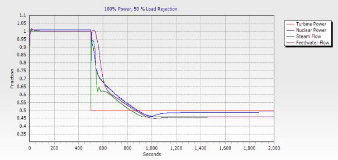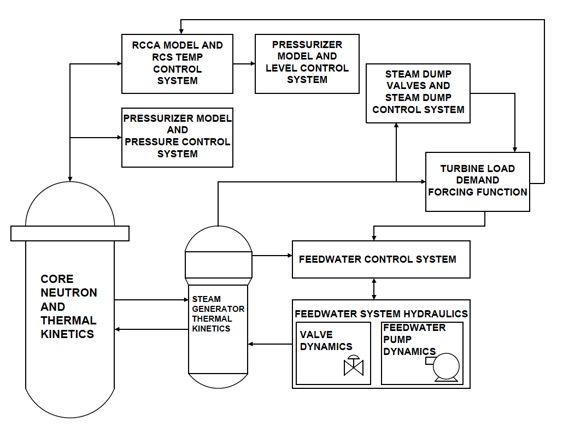Analog and digital control systems frequently perform poorly due to improperly selected control setpoints that resulted from on-the-fly tuning. To help address tuning problems, Westinghouse has developed a Nuclear Steam Supply System (NSSS)/Feedwater (FW) control system & plant model for use in modeling evaluations. It can also be used for support of on-site control system tuning. The NSSS/FW control system model has been developed for use with Westinghouse, Combustion Engineering (CE), and non-Westinghouse designed plants worldwide.
The Advanced Continuous Simulation Language (ACSL) has been used to model both new and existing NSSS/FW Control systems to simulate and analyze dynamic transient behavior.

ACSL is widely used for modeling continuous systems described by time dependent, non-linear, differential equations. The ACSL software is validated by over 30 years of use in a variety of industries for modeling and simulation of dynamic systems and processes. Westinghouse has been using the ACSL software models to simulate nuclear plant processes for over 25 years with predictable and reliable results. Westinghouse engineers have used this base of knowledge and experience in the nuclear industry combined with this special-purpose software to develop the NSSS/FW control system model.
The NSSS/FW control system model uses first principles to model many of the plant control systems and associated relevant plant processes. Below is a brief listing of the plant process models and control system models that have been developed as part of NSSS/FW control system model.
Each analysis begins by taking the NSSS/FW control system model and creating a plant-specific model. Plant data is first collected, including design basis information, process information (including valve and pump curves), physical plant characteristics, state points, historical plant computer data and operational procedures, and then incorporated into the model to create a plant-specific version of the NSSS/FW control system model. After all available plant specific data is incorporated into the model, a series of closed-loop transients, relevant to the desired analysis, are executed over normal plant operating conditions. Each evaluation offers a team-oriented implementation which provides the customer with a plant-specific model and stand-alone supporting engineering report. The completed report can be leveraged by experienced Westinghouse engineers during on-site control system tuning.
The NSSS/FW control system modeling allows for control system setpoints and tuning values to be analyzed and evaluated over a wide range of transients and plant conditions. Using non-real time testing in a simulated environment allows plants to easily refine and evaluate control system performance over a range of transient scenarios. These evaluations and modeling results can lead to:

Simplified Schematic Overview of Westinghouse ACSL Model
Westinghouse has utilized the ACSL-based NSSS/FW control system model for many nuclear PWR and BWR power plants over the last 25 years, both domestically and internationally. The NSSS/FW control system model is proven and has been successfully used to support the design of existing analog and new digital control systems. The NSSS/FW control system model can be used in an integrated manner or used as standalone analysis tool to provide control system setpoint and tuning recommendations.